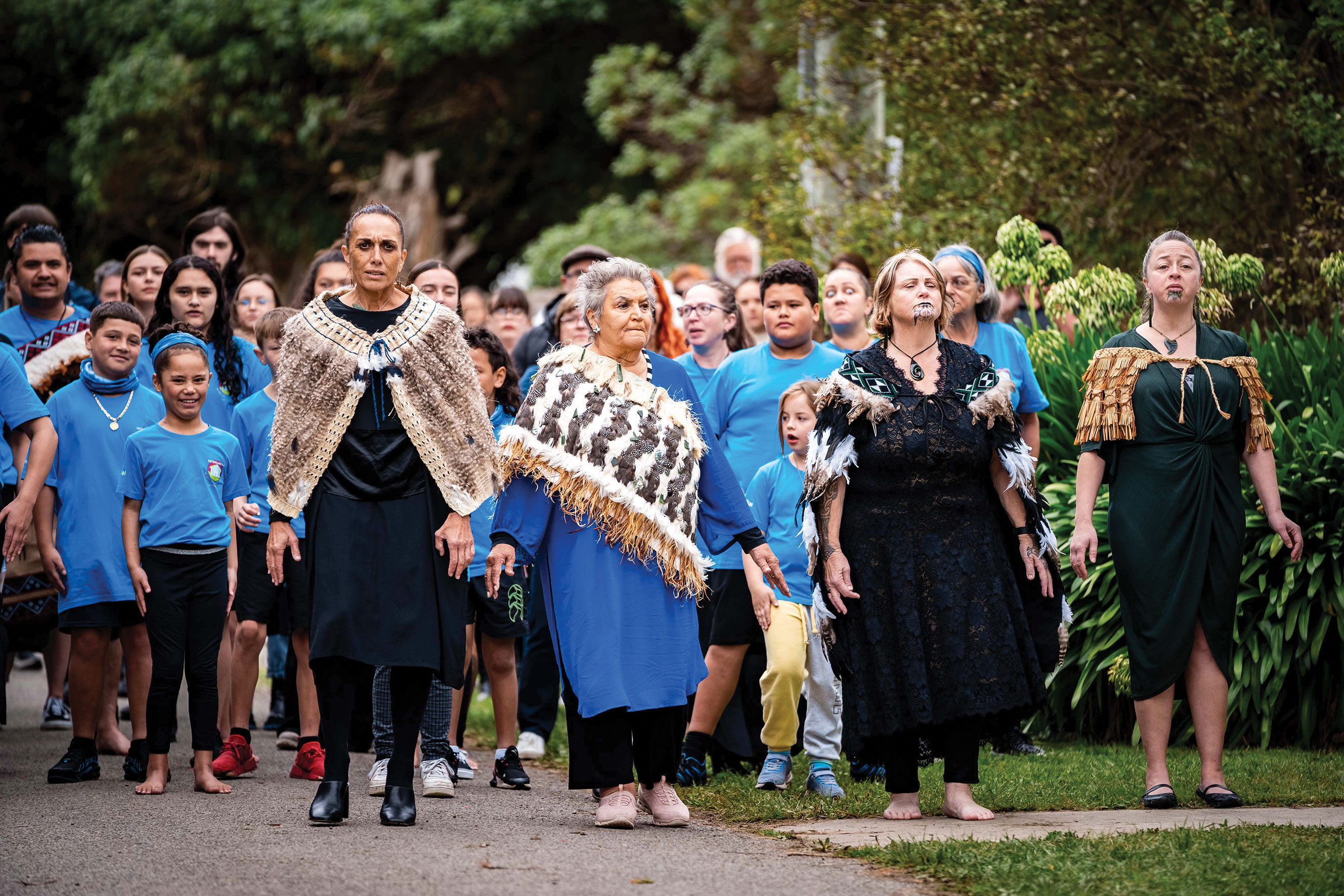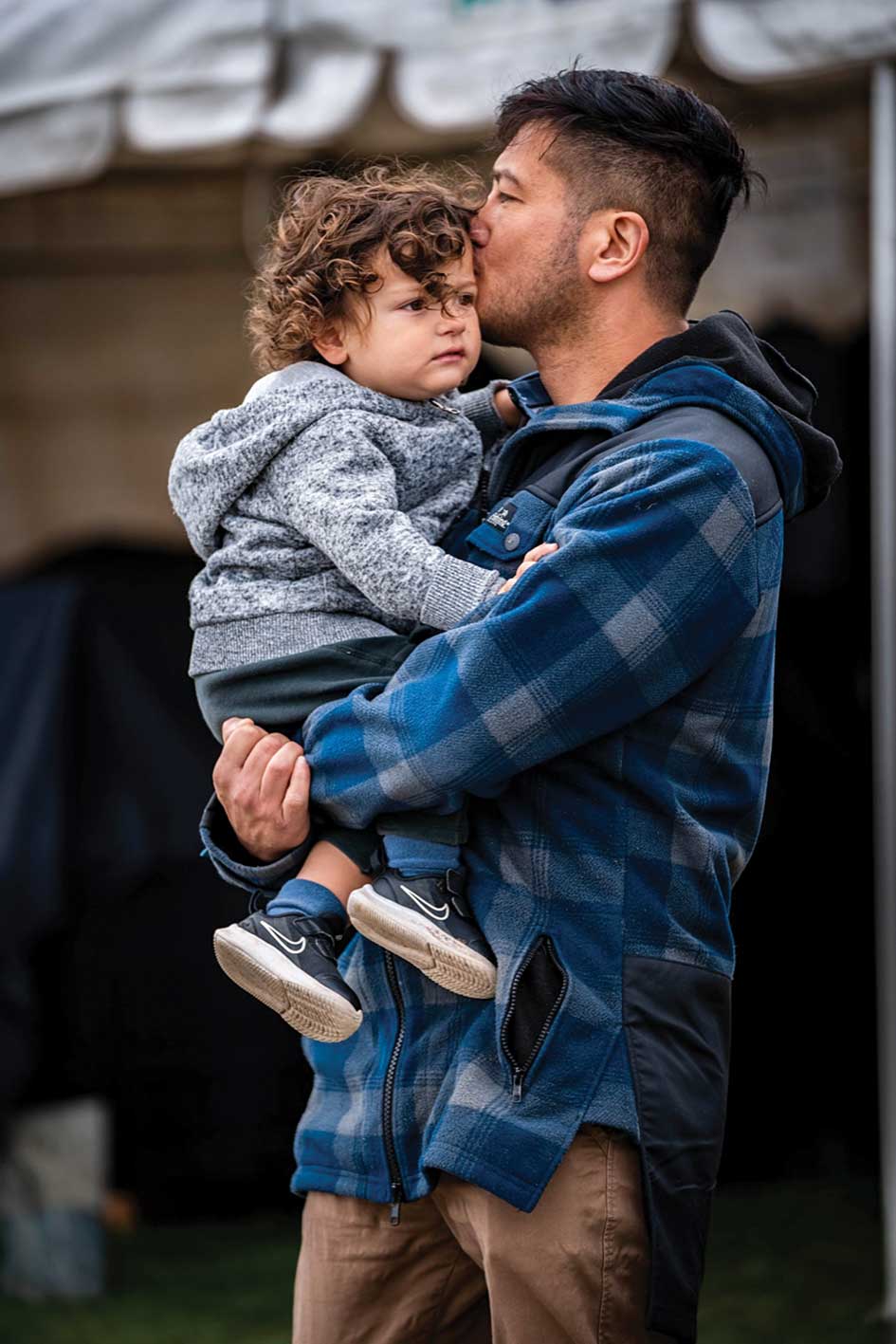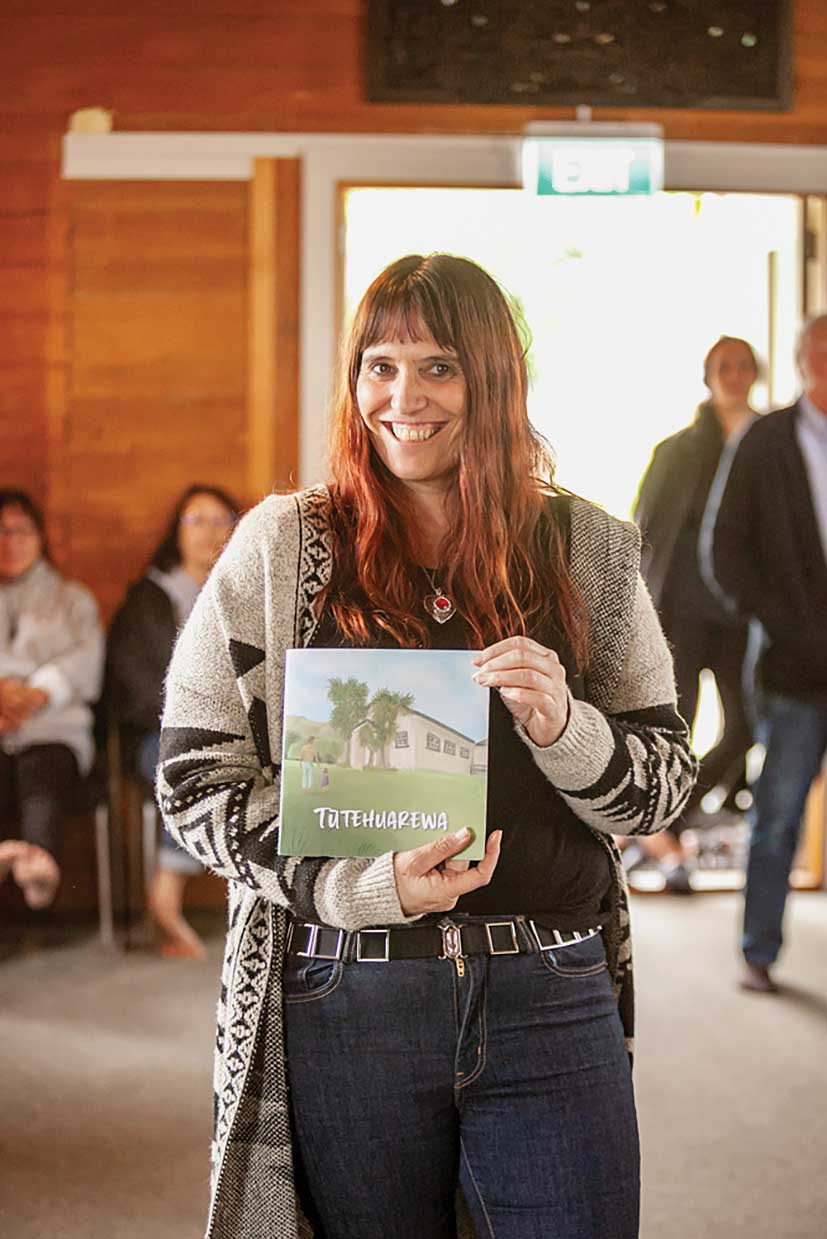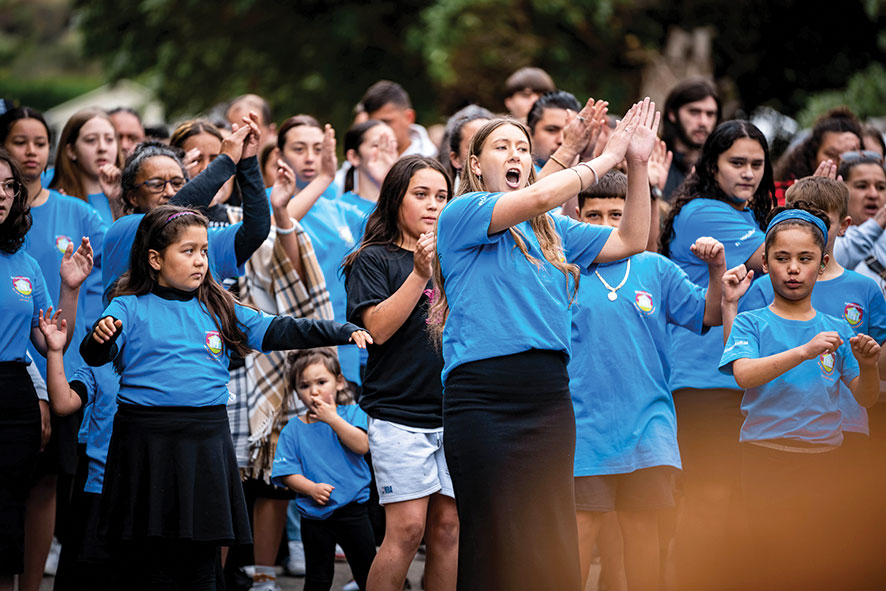Tūtehuarewa: a wahine to unite, 100 years on.
Jul 12, 2023

Nā Pirimia Burger.
They say about 400 people lived at Koukourarata in the mid-1800s, making it the biggest settlement in Canterbury. That’s a bit of a head scratcher when you stand on the only road in and out of the bay, and a lone resident drives past with a relaxed wave. Truly, you can almost hear a line drop into the water at the end of the wharf some days.
But if you saw Koukourarata at Easter 2023 – no imagination needed. The place was teeming with whanaungatanga, intelligence, kotahitanga, pride, talent, laughter, waiata and hope. All in the name of the tipuna wahine, Tūtehuarewa and the 100th birthday of the whare named in her honour.

A Pā transformed
“Seeing moko meet and play, whānau enjoying the moment.” Giant water tanks and shower blocks rolled in on booming trucks. Poles clanged as enormous marquees were erected and flooring rolled out. Whenua thundered as camper vans drove on and tent pegs were hammered in. Microphones hummed with expectation. An ambulance stood sentinel. Tamariki were painted up with moko stencils, then scattered off to the beach to run gleefully wild as adults watched on. Whānau, friends, leaders, kaimahi, reporters, artists, tamariki – the place was thriving.
Tūtehuarewa, the hall and whare at the heart of the community has housed, nurtured and protected her people for a century. A dance hall, native school and site for many commiserations and celebrations. Across three days, more than 1300 people made the trip up and down the infamous winding road to be part of the centenary.
This was a once- in-a-lifetime experience, and people felt that.
The Wero begins
“I loved how it facilitated our whānau reconnecting back to our hapū.”
From late 2020, a small group of women from the hapū volunteered to research and design a centenary programme. Early on, it was evident just how little was known about Tūtehuarewa – either the tipuna or the hall. It was not even clear when the whare was opened. Reclaiming these stories pushed the group over long months and late nights. Eventually, archives showed that Easter was the time to align the 2023 centenary with the date of the hall’s first use in 1923. A three-day programme emerged: a day for Koukourarata whānau; an open day; and a games day. The theme was He Rau Tau, He Tini Mahara | 100 years, 1000 memories.
Good things take time

“Social media proved to be a fantastic way to stay connected before, during and after. I live in Western Australia.”
Over the next 18 months, giant wheels began to turn. A centenary waiata was composed, research for stories about the hall got underway, logos were designed, photos were taken, a pēpi book was written and illustrated, taonga were envisaged and commissioned, giveaways were rustled up, archives were dusted off, interviews were conducted, cooks were approached, relationships were forged, rūnanga were called on, whitebait collected, registrations loaded and media attention garnered. All of this was done, on the whole, by people of Koukourarata.
A digital community also grew. Across the country and the world, whānau learned about the centenary on Facebook. They asked questions, shared memories, introduced themselves and enjoyed kaumātua memories, and introductions to rangatahi, that were drip fed as the celebrations drew closer. Not only did the technology help to build excitement and keep whānau informed, it also let those who could not make it stay involved.
A treasured welcome home
“It was a beautiful way to reconnect with whānau and our whenua. My tamariki are still talking about the connections they made.”
By Easter 2023, as whānau made the journey to Koukourarata from near and as far as Australia, Tūtehuarewa herself was dressed to the nines to welcome them home.
Looking directly at each person who entered Tūtehuarewa, stood a kahu huruhuru dated to around 1890, the first taonga to karanga to her people. The kahu was made by Koukourarata weavers over 130 years before. Behind her stood an exhibition of taonga from a century and beyond. A row of large Perspex cases lined the centre of the whare displaying, among other things, an intricately woven and lined tea cosy made from whītau (flax fibre) by Huihana Tuatini Ruru (1844- 1916); a pounamu pendant from 1800; and original documents from the Crown’s 1849 “purchase” of the Port Levy Block. On either side stood banners with snapshots of local history from the era of Tūtehuarewa and her grandfather, Huikai, to today.
Hon Rino Tirikatene, whanauka and MP for Te Tai Tonga, hand delivered a copper jug, which had been kept safe in his whānau for 101 years. The engraved jug was won by his taua (Mrs E.T. Tregerthen) Ruti Matekino Solomon at the annual Port Levy Easter regatta in 1922. He explained to a packed whare, and those watching the live feed on screens in the marquee, that his taua won first place in the motorboat category in Sweet One racing up and down Te Ara Whānui a Makawhiua while the hall was being built. Her jug sat safely in a case not far from her photo on the back wall of Tūtehuarewa. Minister Tirikatene also launched a book of stories about Tūtehuarewa. Contemporary taonga were also admired.
A striking carved coffee table captivated lovers of all things tactile. A laser-cut sculpture of Te Pātaka o Rākaihautū took centre stage, surrounded by palm- sized stones from each bay in the Koukourarata takiwā and flanked by large slabs of pounamu for curious hands to touch and hold. Nearby, people rested on a carved seat gifted by Kaikōura whānau – no surprise, in the shape of a whale.
All the feels
“Loved the Friday being dedicated to whānau. It is an event I will treasure with my whānau forever.” Whānau, many of whom had brought photographs of their loved ones home to hang on the wall, were deeply moved. Many wept silently as they walked among the taonga learning about their tīpuna and whenua. This included kaumātua of the bay. The experience had something for all. More information was shared by the Whakapapa Unit at Te Rūnanga o Ngāi Tahu. After launching the pēpi book about Tūtehuarewa, all ages pitched in to learn the haka pōwhiri for the next day. The kai marquee soared with waiata ā ringa, reo and laughter. By the time the karanga went out the next morning, the kapa – bolstered by new members – was strong and bold.
Special reasons for everyone
“I am grateful that a sense of healing, whanaungatanga, manaaki and wairua was present at Tūtehuarewa.”Amidst the fun and activities there were poignant moments throughout. While hundreds of people remarked on the joy of reconnecting with whenua and whānau, there were others who had only just discovered their whakapapa Ngāi Tahu, let alone their direct link to Koukourarata. They were bravely setting foot on their whenua for the first time, sometimes in generations, bringing their children and mokopuna with them.
Others had heard of Koukourarata, maybe seen photos, but never visited or known how they connected. Some were returning as adults after childhood memories were made there decades earlier. And, of course, there were whānau who have always kept the home fires burning. They were excited to see so many people return and welcomed them back with pride. Nowhere was this more powerfully felt than the pōwhiri.
Haka Pōwhiri
“It was exhausting but I was really happy.” The waka Kōtukumairangi took everyone’s breath away as she glided into Te Ara Whanui a Makawhiua with grace and power. The day before, kaihoe had left Whakaraupō (Lyttelton) in the pitch black of pre-dawn to paddle the waka to its destination. Cold, wet and dedicated, they arrived three hours later bringing the morning sun with them. The waka was there for the pōwhiri, and as a reminder that the most common access route to Koukourarata for centuries, has been by water.
Four kaikaranga upheld their role with mana, calling to the ope and backed with presence from the kapa behind them; the young faces among them giving promise for the future. The paepae was eloquent and thoughtful, populated by men who embodied the dreams of those no longer there to see them. It was all the fruition of development and investment that has gone into the human potential of Koukourarata, so that its people can stand with confidence on their whenua to recognise their milestones in their way, in their reo and in their rangatiratanga.
Activities went on throughout the weekend; commemorative tree planting, hāngī, housie, karaoke, a time capsule, an Easter egg hunt, walking tours, rangatahi panel – nothing was untouched. A photo of the Tūtehuarewa Concert Party from c.1925 celebrated the kapa who performed around Canterbury to raise money to build the hall. The members’ names were the same names carried by people at the celebration, generations on. Equally, the original roll of pupils who attended the Native School in Tūtehuarewa was captivating. Hine Te Wai was open from 1924 to 1936. All of the tamariki named on the roll were the taua and poua of people in Tūtehuarewa listening to the kōrero in 2023. As the list of pupils was read out, gasps whipped around the whare as that person’s descendant heard their ancestor’s name.
What whānau said
“Grateful for it all. I got books and hoodies for whānau, even in Aussie.”
“Thank you so much for welcoming us. The experience was first time visit to a marae. That was wonderful.”
Every person at the centenary has their own version of what happened. As many stones as there are on the beach, so are the number of experiences.